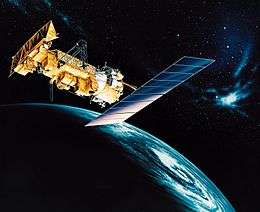NOAA-14
NOAA-14 (or NOAA-J) was a U.S. weather satellite operated by the NOAA. NOAA-14 continued the third-generation operational, Polar Operational Environmental Satellites (POES) series operated by the National Environmental Satellite Service (NESS) of the NOAA. NOAA-12 continued the series of Advanced TIROS-N[6] NOAA-14 was launched on an Atlas E rocket on December 30, 1994 from Vandenberg Air Force Base, California.
| Mission type | Weather |
|---|---|
| Operator | NOAA |
| COSPAR ID | 1994-089A |
| SATCAT no. | 23455 |
| Spacecraft properties | |
| Manufacturer | Lockheed Martin[1] |
| Launch mass | 1,420 kilograms (3,130 lb)[2] |
| Dry mass | 1,050 kilograms (2,310 lb)[2] |
| Power | 330 watts |
| Start of mission | |
| Launch date | December 30, 1994, 10:02 UTC[3] |
| Rocket | Atlas-E Star-37S-ISS |
| Launch site | Vandenberg SLC-3W |
| End of mission | |
| Disposal | Decommissioned |
| Last contact | May 23, 2007[4] |
| Orbital parameters | |
| Reference system | Geocentric |
| Regime | Low Earth Sun-synchronous |
| Semi-major axis | 7,223.0 kilometers (4,488.2 mi) |
| Eccentricity | 0.0010311 |
| Perigee altitude | 845 kilometers (525 mi) |
| Apogee altitude | 859.9 kilometers (534.3 mi) |
| Inclination | 98.6438 degrees |
| Period | 101.8 minutes |
| RAAN | 256.2776 degrees |
| Argument of perigee | 132.7926 degrees |
| Mean anomaly | 227.4116 degrees |
| Mean motion | 14.141173332 |
| Epoch | July 7, 2018[5] |
| Revolution no. | 21296 |
Advanced TIROS-N | |
Instruments
| Instruments[2] | |
|---|---|
| Argos | Argos Data Collection System |
| AVHRR/2 | Advanced Very High Resolution Radiometer/2 |
| HIRS/2 | High-resolution Infra Red Sounder/2 |
| MSU | Microwave Sounding Unit |
| S&RSAT | Search and Rescue Satellite-Aided Tracking System |
| SBUV/2 | Solar Backscatter Ultraviolet/2 |
| SSU | Stratospheric Sounding Unit |
| SEM/MEPED | SEM / Medium Energy Proton Detector |
| SEM/TED | SEM / Total Energy Detector |
NOAA-14 was in a morning equator-crossing orbit and was intended to replace the NOAA-12 as the prime morning spacecraft. The goal of the NESS polar orbiting program was to provide output products used in meteorological prediction and warning, oceanographic and hydrologic services, and space environment monitoring.
The last contact occurred on May 23, 2007.[2]
References
- Vítek, Antonin (March 28, 2011). "1994-089A - NOAA-14". Space 40 (in Czech). Retrieved July 6, 2018.
- "Satellite: NOAA-14". World Meteorological Organization. December 11, 2017. Retrieved July 7, 2018.
- McDowell, Jonathan. "Launch Log". Jonathan's Space Page. Retrieved July 7, 2018.
- NOAA, U.S. Department of Commerce (January 29, 2015). "POES Decommissioned Satellites". Retrieved July 7, 2018.
- n2yo.com. "NOAA 14". Retrieved July 7, 2018.
- NASA, Goddard Space Flight Center. "NOAA-14". NSSDCA. Retrieved July 7, 2018.

External links
![]()
- NOAA 8, 9, 10, 11, 12, 13, 14 (NOAA E, F, G, H, D, I, J). Gunter's Space Page
- SPACEWARN Bulletin Number 495 NASA NSSDC
- Orbital Tracking
